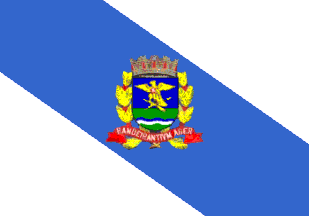

 image
by Marco Aurélio Ebner and Joseph McMillan
image
by Marco Aurélio Ebner and Joseph McMillanFirst hoisted 1952

Last modified: 2015-01-11 by ian macdonald
Keywords: sao paulo | ribeirao preto | stripe (diagonal) | eagle (gold) | coat of arms |
Links: FOTW homepage |
search |
disclaimer and copyright |
write us |
mirrors


 image
by Marco Aurélio Ebner and Joseph McMillan
image
by Marco Aurélio Ebner and Joseph McMillan
First hoisted 1952
Other sites:
The flag of Ribeirão Preto was devised in 1952 in preparation for the cityís
hosting of a sports festival involving 5,000 athletes from cities in São
Paulo, Minas Gerais, Paraná, and Mato Grosso. For the opening of the games, the
cities were supposed to parade with their flags, but the host city didnít
have one. So the organizing committee sponsored a public contest to design
a flag. When no one entered, a municipal employee assigned to assist in
organizing the games, Pedro da Silva Salles Júnior, presented several
designs for a municipal flag and a sports emblem. One of his designs for
the municipal flag was adopted by the committee. The colors of the flag,
blue and white, were inspired by the streams that cross the city (blue) and
the peace that reigns between the authorities and the citizens (white). On
the center is the shield of the city. The coat of arms was adopted by law
95 of 20 June 1949. The idea was that of Guilherme de Almeida (a very
famous poet who wrote the poem to the São Paulo state flag that is now the
state anthem) and the artistic design was by José Wasth Rodrigues (a
well-known heraldic artist of the time who also designed many military
insignia, flags, etc., including the standard of the Agulhas Negras Military
Academy). The coat of arms is divided per fess. The upper half is blue
with a gold eagle, wings extended, its head turned to the right, armed
gules, carrying on his breast an escutcheon (red with a bandeiranteís
leather jerkin) and in his talons rifle and a miner's pickaxe.
The lower half is green with a bar wavy parted wavy blue
and white. On the mural crown is another escutcheon, blue with a gold
episcopal staff and crossed arrows. The shield is flanked by braches of
coffee. The motto is Bandeirantium Ager.
Despite having been created in
1952, the flag has not yet been adopted officially, nor has it been recognized by the
federal or state governments.
Sources:
www.terradocafe.hpg.ig.com.br, and www.ribeiraonet.com.br.
Joseph McMillan, translation corrected by Francisco Santos, 21 March 2003
See a detailed picture of the
coat of arms at
www.ribeiraopretoespecial.hpg.ig.com.br. In that site the motto Bandeirantium Ager is translated as "Campo
dos Bandeirantes" ("Bandeirantes' Field").
Francisco Santos, 21 March 2003
The word ribeirão means "large torrent", though in this case might as well mean just "river."
This is shown in the arms. Preto means "black", a color missing both on the flag and on the arms.
António Martins-Tuválkin, 25 March 2003
Variants of this flag exist, at least on the Internet,
with some having the stripe running the opposite direction and/or with the
stripe white on a blue field. Not surprising for an unofficial flag.
Joseph McMillan, 21 March 2003